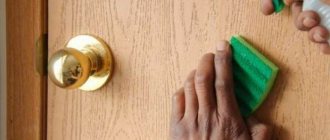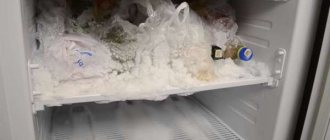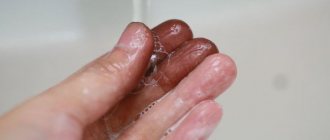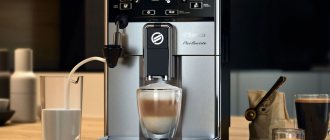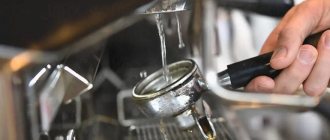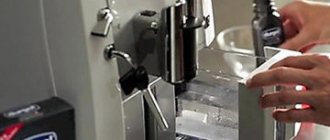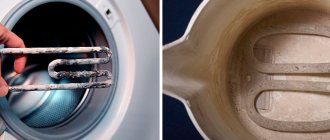Sediment is a common cause of coffee maker malfunctions. The appearance of a thick crust inside the device leads to its overheating and related failures. To eliminate possible problems, it is important to regularly treat the device with a special descaling agent for coffee machines.
Special products are used to descale coffee machines.
How scale forms
Drinking liquid contains various inorganic components that are responsible for its characteristic taste. Under the influence of high temperature, it is heated and breaks down into carbon dioxide and precipitated salts. Over time, these deposits settle on the heater and other components of the coffee machine, creating an additional insulating layer. This impairs the thermal conductivity of surfaces and forces the machine to operate at increased power.
When exposed to high temperatures, scale forms.
How often should you clean your coffee machine?
In principle, the frequency of cleaning this device mainly depends on the quality of the water. If hard water is used, it is recommended to clean it at least every month and a half. For soft water, this period increases to six months. You can wash the machine, focusing on external signs - an indication of the device itself or a change in the nature of its operation. This will be discussed in more detail below.
In addition to decalcification, you need to regularly clean the cappuccino machine - a device for frothing milk. It is recommended to rinse this unit with bottled water after each use, as... milk residues are a favorable environment for the proliferation of microorganisms, including pathogens. In addition, without rinsing, sediment accumulates in the cappuccino maker over time, and this unit stops frothing milk. In this case, it will have to be washed with a special washing liquid.
When to clean the device
If the coffee maker is used daily, it is recommended to remove sediment every month. Progressive models are equipped with an electronic control option, which automatically notifies about the degree of contamination of the equipment and the need for preventive cleaning. If such a system is not provided, you can take into account the number of portions brewed recently. The average is 200 cups of drink.
Cleaning Frequency
The frequency of decalcification of the coffee machine is determined by the degree of water hardness. The higher it is, the more often you will have to clean the device.
You can determine high salt concentrations using a kettle. If contaminants form frequently and quickly, it means the water is hard.
Critical signs that cleaning is needed
The following signs indicate that cleaning your coffee machine with descaling liquid is urgent:
- The coffee maker “leaks”, puddles of water remain after use;
- There is noise, a hum, the device is clearly louder than before;
- Drinks are prepared more slowly, this is due to the fact that the tubes are clogged or the heating process takes longer;
- There is a clear whitish coating, particles, flakes in the cup or jug, a strange aftertaste has appeared;
- Espresso crema is clearly not as dense. If you did not change the coffee, it means that the pressure in the system has changed due to plaque.
In this case, you should not use the coffee machine at all until you carry out decalcification: clogged pipes, overheating of the entire system and other factors can lead to breakdown or burnout. According to statistics, most often coffee makers break down and fail completely because of scale, so the problem is not far-fetched. If you value your coffee machine, you should take care to select a good descaling liquid and use it regularly.
Rules for cleaning coffee machines with different coatings
The specifics of flushing depend on the material used to make the device. Some coffee machine surfaces require more careful care, while others are not afraid of the effects of abrasive compounds.
Ceramics
Cleaning ceramic surfaces is carried out in stages. To begin, pour 500 ml of liquid into the container of the coffee maker and add 2 tbsp. l. soda After boiling the components for 30 minutes, 20 g of citric acid is added to them. The cleaning mixture is brought to a boil again.
Cleaning ceramics is done in stages.
Plastic
You cannot clean plastic surfaces with vinegar. It is replaced with citric acid, adhering to the proportions - 1 packet per 1 liter of water. After the substance dissolves, the liquid is boiled. Cleaning the walls does not happen immediately, so it is better to repeat the procedure 2-3 more times.
Stainless steel
Stainless steel models can easily withstand the effects of vinegar, citric acid and other aggressive cleaning agents. The metal surface is not afraid of repeated washing and retains its clean appearance for a long time. Apple cider vinegar diluted with water in a ratio of 1:10 is suitable for processing.
Stainless steel tolerates citric acid well.
Electrical appliance
Vinegar should not be used when cleaning plastic-coated electrical devices. If the product is metal, you should prepare a cleaning solution based on 500 ml of liquid and 200 ml of 9% vinegar. The mixture is brought to a boil with the lid ajar.
How to clean a coffee machine from lime deposits
To perform a thorough cleaning it is recommended:
- Remove any remaining grains and water.
- Pour the required amount of water, focusing on the mark, and a special product.
- Leave the car in a passive state for a while (see the instructions for how long).
- Then you launch your own descaling system.
- The waste liquid must be drained by brewing coffee.
- Afterwards washing is carried out.
Expert opinion
Borodina Galina Valerievna
After such cleaning, the first 2-3 cups of coffee must be poured out; they cannot be drunk, even if the device is washed several times.
What are the features
If you fill the device with bottled or filtered water, then cleaning should be done once every three months or six months.
Since there are many cleaning products available, you need to determine the best one:
- The label should say: “For cleaning plaque.” Any other means will not work.
- After preparation, the product should be used immediately. The tablets must be dissolved in water in advance.
- If this is a branded device, then you need to use products designed specifically for this company.
- Semi-automatic or drip coffee makers can be cleaned with universal substances. The difference between them and specialized products is the price. Universal ones are much cheaper.
- Removal of deposits in expensive, branded models is carried out only following the instructions.
Anti-scale products
Cleaning products for the care of coffee makers are divided into several groups. The following types are particularly effective:
- Chemical cleaners.
- Softener filters.
- Decalcifiers.
Chemical
These products contain various acids. They are allowed for models coated in plastic, glass or steel. The substances are highly effective, but can negatively affect built-in automation and rubber seals.
Chemicals contain various acids.
Softening filters
They are distinguished by their ability to reduce water hardness, preventing the accumulation of plaque. After use, magnesium and calcium ions turn into sediment and do not interact with the heater.
Decalcifiers
There are 2 types of decalcifiers available for sale that can be used to clean the coffee maker:
- Pills. They are a mixture of chemical components that are compressed into a single substance for easy use.
- Liquid formulations. The cleaner dissolves instantly and does not contain any solid particles that may remain inside the machine.
Decalcifiers can be used to clean your coffee maker.
Pros and cons of decalcifying liquids
As with any other type of decalcifier, liquid products have their pros and cons. Each consumer himself chooses what is more convenient for him, or what to use in a particular case.
- It is more convenient to dose the concentration. If the cleaning was carried out a long time ago, you can always pour a little more than the standard dosage, or, conversely, clean the coffee machine with a “stronger” decalcinator, pouring just a little.
- There are universal means. That is, you don’t need to buy several jars - the same liquid will clean all the parts, it’s faster and in some ways cheaper.
- The product dissolves instantly without sediment. Pour it into the water and you can immediately start the cleaning process. Not a single particle, even a tiny one, can stay inside.
The downside is that descaling liquid in a coffee maker loses its properties faster than tablets. And there is a risk of spilling the drug, that is, it is not always convenient to transport or pour it.
Folk remedies
You can remove scale from your coffee machine using proven folk remedies. Their effectiveness has been proven by the experience of many users and experts.
Cleaning with citric acid
The method allows you to remove fresh scale from the coffee maker, which has not formed a thick layer and has not become hard. The food additive is safe for all plastic, metal and glass surfaces. To prepare the solution, you need to use 2 tbsp. l. acid diluted in 0.5 liters of water, which will allow you to obtain an effective and not overly aggressive composition.
Cleaning with citric acid removes fresh scale.
Cleaning with brine
The brine needs to be poured into the coffee machine reservoir and boiled for 25-30 minutes.
After this time, the contents will need to be shaken and waited until it cools completely. The method allows you to eliminate rust and sediment.
Cleaning with soda
The soda contains phosphoric acid, which effectively fights salt deposits on the surfaces of the device. It is recommended to use clear drinks when cleaning the coffee maker. Before using the liquid, the gas must be released to prevent the formation of foam. To do this, shake the bottle, and then carefully open it and wait until the bubbles are released.
Soda fights salt deposits.
After this, the soda can be poured into the device, boiled and waited for cooling.
Cleaning coffee appliances
Horn-type devices . There is a special compartment for brewing. During operation, the element retains sediment and coffee oils on the walls. In such devices, the main part is the horn (responsible for the functioning of the brewer).
With removable block . Remove the removable compartment and wash it with water. After washing, you need to put the part back in place. The cleaning procedure is performed every 3-4 weeks.
With built-in steam generator . In such devices, cleaning is carried out automatically. For this purpose, the drug is used in the form of tablets. If you use the device incorrectly, it will soon stop working.
The cleaning process is carried out in eight stages:
- You need to remove the coffee from the steamer.
- The product must be placed in the compartment for ground beans.
- Fill the device with 2 liters of water.
- Set the cooking mode.
- We set the capacity under the nose of the distribution.
- In setup mode, select the maximum volume.
- Pour out the cup with liquid.
- At the end of the procedure, the device should stand for thirty minutes.
- After the time has passed, the device is washed.
Features of cleaning individual elements of the coffee machine
When refinishing a coffee maker, it is important to clean several elements separately. Among them:
- Cappuccino maker.
- Brewing unit.
- Holder.
Holder
After the part is removed from the machine, a dark residue may be visible on it. To wash the device from dirt, use hot water, immerse the holder there for 20 minutes, and then wipe with a foam sponge (hard surface).
The holder is the part of the coffee machine into which the filter is inserted.
Cappuccino maker
Before processing the component, it is necessary to get rid of condensation. Then the part must be immersed in a container with hot water and soda for 20 minutes.
To completely remove scale, the surfaces should be rubbed with a sponge, rinsed and dried with a dry cloth.
Infuser
After 2 weeks, the brewing unit is removed from the machine and washed under clean water. Then it needs to be installed in its original place. If the part is not removable, then you need to place a cleaning tablet in the department for ground beans, place a large container under the horn and turn on the coffee brewing cycle.
The infuser is removed from the machine.
Cleaning the brewing unit, including removing coffee oils
Any grain coffee machine has a brewing unit (in carob coffee makers, its functions are performed by the horn, in capsule coffee makers - by the capsule), which over time becomes contaminated with particles of ground coffee and its oils. Coffee machines are divided into two large classes - with a built-in brewing device (hereinafter referred to as the charger) and with a removable one (which is better - read in the “Frequently asked questions”).
Tablets for cleaning coffee machines from oils. They are suitable not only for Bosch, but for everyone.
Actually, the issue of cleaning is the cornerstone of this division. The removable charger can (and should!) be taken out and washed once every 1-3 weeks under running water (from the tap), then allowed to dry and installed back into the car. But in addition to this express rinsing, once every 200-500 cups, it is recommended to clean the charger and hydraulic circuit of the coffee machine with special tablets for cleaning coffee oils.
And if for units with a removable charger this is still a recommendation, but I would not say that it is a strict requirement, then devices with non-removable chargers (Jura, Krups) absolutely need to be cleaned with such tablets strictly at the request of the machine (it will definitely give a signal), otherwise they 100% won't last long.
With “coffee system cleaning tablets” or “coffee oil tablets” (these are the most common names for such products), the situation is exactly the same as with descaling products. That is, all manufacturers are afraid that only their branded preparations can be used, although in reality they are all the same, and you can also use “non-coffee oil tablets are harder to find. Of the original ones, by tradition, the most affordable are Bosch (10 tablets per pack: in Yandex.Market) and Melitta (in Yandex.Market). Among the “non-original” ones, one of the most affordable (about 2 times cheaper than branded ones) is Topper 3037 (in Yandex.Market). Backup options are Cafedem or Cafiza tablets (in Tasty Coffee, in Yandex.Market).
Usually the process is described in detail in the instructions, but sometimes manufacturers are completely silent about the need for such cleaning. For example, DeLonghi says nothing in any of the manuals. You don’t have to do this kind of cleaning, but it’s still worth it. If the instructions do not describe the process, then you need to do this:
- Make sure that your model has a shaft and a corresponding program for brewing coffee from pre-ground beans, in short, from ground coffee.
- Activate the “Ground coffee” preparation mode.
- Throw one tablet of the product into the ground coffee chamber.
- Place a large cup under the dispenser and start brewing the largest possible volume of espresso.
- Pour out the water.
- Repeat two maximum volume espresso preparations using pre-ground coffee, WITHOUT adding ground coffee. Drain the water dispensed by the machine into the sink.
The coffee oil cleaning tablet should be thrown into the ground coffee chamber.
What if I don’t have a shaft for ground coffee or the machine doesn’t want to start brewing with a tablet, without coffee?
Option for machines with a dedicated coffee rinsing button, for example Delonghi
- With the machine turned on, you throw the tablet into the ground shaft, you can crush/crush it and add the powder. In this case, then, before the last point in these instructions, pass the brush along the shaft to throw down the remaining powder if it remains on the walls.
- Press flush, which is a separate button on the control panel.
- When about 10-20 ml pours out of the machine into a glass, pull the plug out of the network. Yes, right in the process of work.
- Wait 10 minutes.
- Turn on the machine, it will throw the remaining tablet into waste, this is normal.
- Rinse the coffee tract with the same rinsing (button on the panel) 6-8 times.
Option for machines without a dedicated coffee path rinsing button/program
There are coffee machines (for example, Philips HD8649, HD8827/8829) without a shaft for ground coffee. Also, some coffee machines with a shaft have a sensor that detects the presence of coffee in this shaft, and if there is only a tablet and not coffee, the machine does not start the brewing process.
This is the most difficult case. In principle, if you regularly wash the teapot under running water, then you don’t have to do this cleaning. But there is a “hack” with approximately half effectiveness:
- In case of a “hack” we put the oil tablet here
Take out the teapot with the machine turned off.
- You wash it and dry it.
- Place a coffee oil tablet in the removed brewer, in the coffee compartment (the funnel on top where ground coffee from the coffee maker is poured), and you can crush/crumb it. In this case, then, before the 8th point in these instructions, pass the brush along the shaft to throw down the remaining powder if it remains on the walls.
- Insert the teapot into the machine and turn on the machine. She will start to wash out,
- After approximately 10 ml has flowed out of the dispenser, turn off the machine by unplugging the power cord. Yes, right in the process of work.
- Wait 10 minutes.
- Turn on the machine - it finishes the washing procedure, returning to its original state.
- After this, it is necessary to rinse the coffee path. Depending on the model, forced flushing may be a separate item in the menu or a button. This may not be the case. Then you just turn off and then turn on the machine a couple of times, at the time of each turn on it is usually always washed. Well, or you make sacrificial coffee of the maximum volume - for draining.
- Cleaning is complete. There may be a half-dissolved tablet in the pulp compartment - discard it.
Criteria for choosing descalers for a coffee machine
To make the right choice of descaling agent for your coffee maker, you need to use the compositions recommended by the manufacturer. Some models are incompatible with common substances and require careful care.
There are no restrictions on the form of the cleaning substance. Tablets are easy to store, but take longer to dissolve. The gel acts quickly, but it lasts for 3-4 treatment cycles. The liquid consistency has a lower content of active substance, but is highly effective.
What happens if the coffee machine is not cleaned?
If you do not periodically carry out comprehensive cleaning of the coffee machine, then over time it will simply fail. First, the taste of the drink will change for the worse and its output portion will decrease. Then the operation of the machine mechanism may be disrupted, and the hole through which the prepared drink enters may become completely clogged. As a result, the device becomes unusable and is not always repairable; you often have to buy a new model.
Rating of the best funds
To quickly descale your coffee machine, you need to use only proven tablets and cleaning products. The rating of the best drugs, according to reviews from experts and users, will help simplify your choice.
DeLonghi EcoDecalk
EcoDecalk is a new decalcification product that has an environmentally friendly composition and is suitable for all models. The liquid is based on raspberry and citric acids and is available in 500 ml bottles. This volume is enough for 5 processing cycles.
DeLonghi EcoDeca is a descaling product.
Philips Saeco Decalcifier
Philips Saeco Decalcifier is designed to care for Gaggia, Philips and Saeco coffee machines. It is sold in 250 ml bottles and is gentle on the internal surfaces of the device. The result of the treatment appears after a few minutes.
TOPPERR 3006
The concentrated composition ensures gentle but effective removal of plaque in different models of coffee machines. It is quite convenient to use this drug: you need to dilute it according to the instructions in the specified dosage, pour it into the reservoir and turn on the cleaning cycle. With the TOPPERR 3006 you can process carob and capsule machines.
TOPPERR 3006 is a concentrated composition.
Krups XS 3000
The drug was developed for the Krups XS 3000 model and is used to prevent scale. The tablets are able to cleanse the internal space of deposits and coffee oil.
Bosch Descaling
Bosch Descaling is sold in sealed packaging of 6 pieces. and is intended for quick cleaning of equipment from limescale. Properly selected proportions of ingredients do not have a negative impact on internal surfaces.
Bosch Descaling is designed for quick cleaning of equipment.
Top House
Produced in Germany and characterized by high decalcification efficiency. In addition, it prevents the appearance of rust. For 1 treatment cycle, 125 ml of product is required.
Durgol Swiss Espresso
The Swiss product is in demand among owners of automatic cars. It has a gentle but quick effect and is 5-10 times faster than descaling products from other brands in terms of response speed. Using a cleaning product, you can completely get rid of lime without additionally treating the coffee machine with chemicals.
Durgol Swiss Espresso is in demand.
Bosch
This company produces several descaling products for coffee machines. These are tablets and liquid.
A liquid solution for removing harmful limescale deposits works effectively, but is cheaper than tablets.
How to clean your coffee maker:
- For automatic devices, 100 ml of the product is poured into the water container, the rest is distilled water.
- For coffee makers with a ½ quart filter, the same ½ cup of cleaning agent is used.
The cleaning agent is applied equally to both devices. After adding them to the tank, leave the device alone for 5 minutes. Then the device is turned on for 1 minute, then turned off and left for another 10 minutes.
This sequence of procedures is repeated 3 times. Complete the washing with a special composition by passing the solution through a coffee maker.
Then you need to rinse the cleaned equipment with clean water several times.
Comparison table of characteristics
| Name | Manufacturer country | Release form | Compatibility |
| DeLonghi EcoDecalk | Italy | Liquid preparation | All brands |
| Philips Saeco Decalcifier | Germany | Liquid preparation | Saeco, Philips and Gaggia |
| Krups XS 3000 | Germany | Tablet form | KRUPS Espresseria Automatic and Barista |
| Bosch Descaling | Germany | Tablet form | Bosch, Siemens, Gaggenau, Neff |
| Top House | Germany | Liquid | All brands |
| Durgol Swiss Espresso | Switzerland | Liquid composition | All brands |
| TOPPERR 3006 | Germany | Concentrate | All brands |
What is descaling machine
In the process of preparing coffee, ordinary drinking water is used, which contains calcium salts. There are slightly fewer of them in soft water. However, it is not possible to completely get rid of their presence during the filtration process. Calcium can be deposited on the walls of equipment, elements that are in direct contact with water - in the future, a layer of plaque may form in such areas.
Such deposits interfere with the efficient functioning of the coffee machine - it can work much worse, and the finished drink will acquire additional taste. To prevent this from happening, experts recommend periodically cleaning the coffee machine from the calcium layer. This process is called decalcification.
It is necessary to take into account the fact that water hardness directly affects the amount of plaque formed on the coffee machine. Experts recommend using this process monthly. To avoid the appearance of large amounts of sediment, it is recommended to use bottled water, which will also give a soft and pleasant taste to the drink.
Alternative cleaning methods or what not to do
Owners of household coffee machines sometimes try to save on equipment maintenance and use improvised methods to clean it of mineral deposits and oily deposits. To do this, use citric acid or table vinegar. But they do not take into account that both products are less effective in combating coffee fat and salts than specially designed tablets. Moreover, such “preventions” accelerate the corrosion process, have a destructive effect on metal parts of the hydraulic system, and provoke rapid wear of rubber gaskets. As a result, the espresso machine breaks down more often and requires repair or replacement.
POLL: What drink do you prefer?

